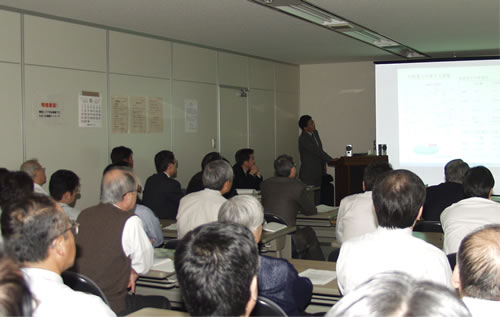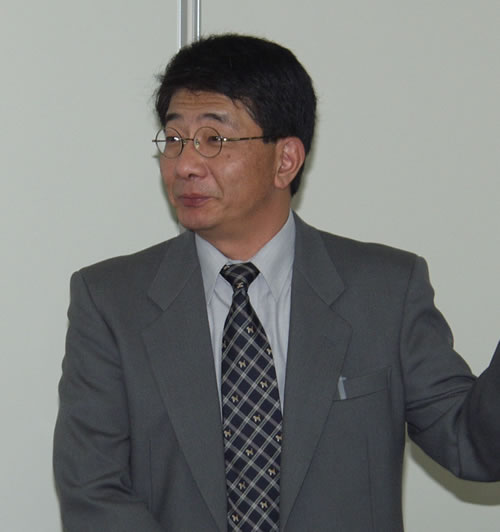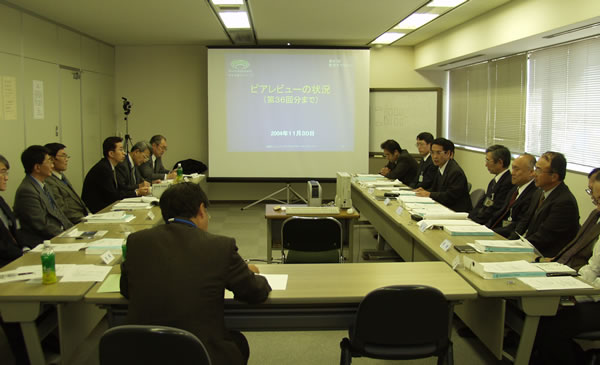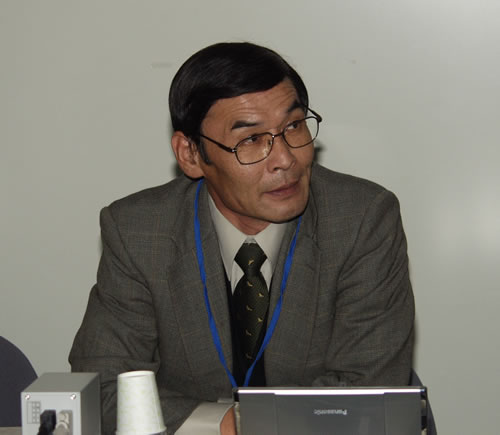|
|
 |
 On 30 Nov. 2004, the 67th Safety Caravan visit was held at Kasai Center, Mitsui Engineering & Shipbuilding Co., Ltd. located in Edogawa -ku Tokyo Japan. On 30 Nov. 2004, the 67th Safety Caravan visit was held at Kasai Center, Mitsui Engineering & Shipbuilding Co., Ltd. located in Edogawa -ku Tokyo Japan.
|
|

Safety Presentation |
 About 40 persons, including the employees of Mitsui Engineering & Shipbuilding Co., Ltd. attended the Safety Presentation. About 40 persons, including the employees of Mitsui Engineering & Shipbuilding Co., Ltd. attended the Safety Presentation.
 At the beginning of the presentation, Mr. Saburo Sakamaki, General Manager of Plant & Environment Hq., Mitsui Engineering & Shipbuilding Co., Ltd., gave an address and said, “Without reference to nuclear power, the professional ethics of nuclear engineers, company compliance, and the like are matters of importance, and in this field we have been taking action company-wide since a long time ago, because the company's continuation will be affected if we cause problems. Mitsui Engineering & Shipbuilding has been carrying out work in relation with nuclear power for approximately 30 years, and I will listen with great interest to today's lecture on safety activities, because it represents a great opportunity to keep contributing to the nuclear power industry”. At the beginning of the presentation, Mr. Saburo Sakamaki, General Manager of Plant & Environment Hq., Mitsui Engineering & Shipbuilding Co., Ltd., gave an address and said, “Without reference to nuclear power, the professional ethics of nuclear engineers, company compliance, and the like are matters of importance, and in this field we have been taking action company-wide since a long time ago, because the company's continuation will be affected if we cause problems. Mitsui Engineering & Shipbuilding has been carrying out work in relation with nuclear power for approximately 30 years, and I will listen with great interest to today's lecture on safety activities, because it represents a great opportunity to keep contributing to the nuclear power industry”.
|

|
|
Safety Presentation
|
 After the address, Mr. Machida, General Manager of NSnet, introduced NSnet activities, and this was followed by a lecture entitled “Quality Assurance Efforts at the Shimane Nuclear Power Generation Plant” delivered by Mr. Kaoru Shintaku, Staff Senior Manager (Nuclear Power), Power Generation Division, The Chugoku Electric Power Co., Inc. After the address, Mr. Machida, General Manager of NSnet, introduced NSnet activities, and this was followed by a lecture entitled “Quality Assurance Efforts at the Shimane Nuclear Power Generation Plant” delivered by Mr. Kaoru Shintaku, Staff Senior Manager (Nuclear Power), Power Generation Division, The Chugoku Electric Power Co., Inc.
|

|
|
Mr. Sintaku
|
 During the lecture, Mr. Shintaku gave a brief presentation of the nuclear power generation business of The Chugoku Electric Power Co., Inc., and as examples of quality assurance efforts, he introduced the conditions of implementation of regular inspections and the response to defects at the Shimane Nuclear Power Generation Plant, under the new national inspection system which started in Fall 2003. He also covered the conception and approach of quality assurance activities that nuclear power generation operators must assume to create a better sense of safety among the public. During the lecture, Mr. Shintaku gave a brief presentation of the nuclear power generation business of The Chugoku Electric Power Co., Inc., and as examples of quality assurance efforts, he introduced the conditions of implementation of regular inspections and the response to defects at the Shimane Nuclear Power Generation Plant, under the new national inspection system which started in Fall 2003. He also covered the conception and approach of quality assurance activities that nuclear power generation operators must assume to create a better sense of safety among the public.
 He said, “Because of the risks involved with radioactivity, extremely high ethics and transparency are required from nuclear power generation as an industrial activity. Because of recent issues such as the criticality accident and concealment of defects, the public is no longer convinced by the simple results of inspections that report that facilities are safe, and the times require that the terms ‘sense of safety’ be considered as key words. He said, “Because of the risks involved with radioactivity, extremely high ethics and transparency are required from nuclear power generation as an industrial activity. Because of recent issues such as the criticality accident and concealment of defects, the public is no longer convinced by the simple results of inspections that report that facilities are safe, and the times require that the terms ‘sense of safety’ be considered as key words.
 So far, safety measures in facilities and efforts for human error prevention have been implemented as the basis upon which the ‘sense of safety’ would be judged, and each time trouble occurred, it was common to declare that we would ‘aim at recovering trust through continuous safe and stable operation’. However, these have lost their convincing power. So far, safety measures in facilities and efforts for human error prevention have been implemented as the basis upon which the ‘sense of safety’ would be judged, and each time trouble occurred, it was common to declare that we would ‘aim at recovering trust through continuous safe and stable operation’. However, these have lost their convincing power.
 From now on, safety is naturally to be expected, and this will not prevent trouble from occurring, but we need a stance where trust will be recovered by having the very process of how we respond to trouble closely examined. The times demand evidence of whether confidence can be placed in the process of our activities, and ‘Quality Assurance’ is an embodiment of this. Operators must be determined in fulfilling their duty of accountability and building and operating a strong voluntary safety system”. From now on, safety is naturally to be expected, and this will not prevent trouble from occurring, but we need a stance where trust will be recovered by having the very process of how we respond to trouble closely examined. The times demand evidence of whether confidence can be placed in the process of our activities, and ‘Quality Assurance’ is an embodiment of this. Operators must be determined in fulfilling their duty of accountability and building and operating a strong voluntary safety system”.
|

Safety information exchange session |

|
|
Safety information exchange session
|
|

|
|
Mr. Nemezawa
|
 At the safety information exchange session, we asked Mr. Isao Nemezawa, Senior Engineer, Nuclear Plant QA & Test Inspection Section, Nuclear Systems Quality Assurance Department, Quality Assurance Division, Hitachi Works, Power Systems, Hitachi, Ltd., to give an in-depth explanation about the good practices cited by the peer review regarding the two topics of “Wide-Ranging Activities for Human Error Prevention” and “Computerization of Information Transmission and Design Management in Design Departments”. At the safety information exchange session, we asked Mr. Isao Nemezawa, Senior Engineer, Nuclear Plant QA & Test Inspection Section, Nuclear Systems Quality Assurance Department, Quality Assurance Division, Hitachi Works, Power Systems, Hitachi, Ltd., to give an in-depth explanation about the good practices cited by the peer review regarding the two topics of “Wide-Ranging Activities for Human Error Prevention” and “Computerization of Information Transmission and Design Management in Design Departments”.
|
The main information and opinions exchanged included:
| ● |
The introduction and operation of 3D-CAD systems being costly, do you consider the profit per engineering work or it as the investment? |
| ○ |
The introduction and operation of 3D-CAD systems being costly, do you consider the profit per engineering work or it as the investment? |
| ● |
Is there a system such that you and your customers can judge together, for example, of what the next inspection should target? |
| ○ |
We have not reached this stage yet, but we try to share as much information as possible with our customers. |
| ● |
Have you decided to avoid producing paper documents by converting documents to electronic media? |
| ○ |
Apart from documents in bound form intended for our customers, such as quality assurance plans, basically we try not to use paper, and because we have decided to give notice of the publication of documents by e-mail, paper documents have decreased sharply, a practice which has developed into a culture. |
| ● |
One may suppose that under time pressure for example, technicians may delay some data input. Are there measures for responding to this? |
| ○ |
At this time, our systems understand the status of data input. This feature is certainly convenient for administrators, but since communication is a matter of importance, we do not rely only on administration implemented by machines, and administrators walk around to inquire about possible problems and take necessary measures. |


|
|
|
|







